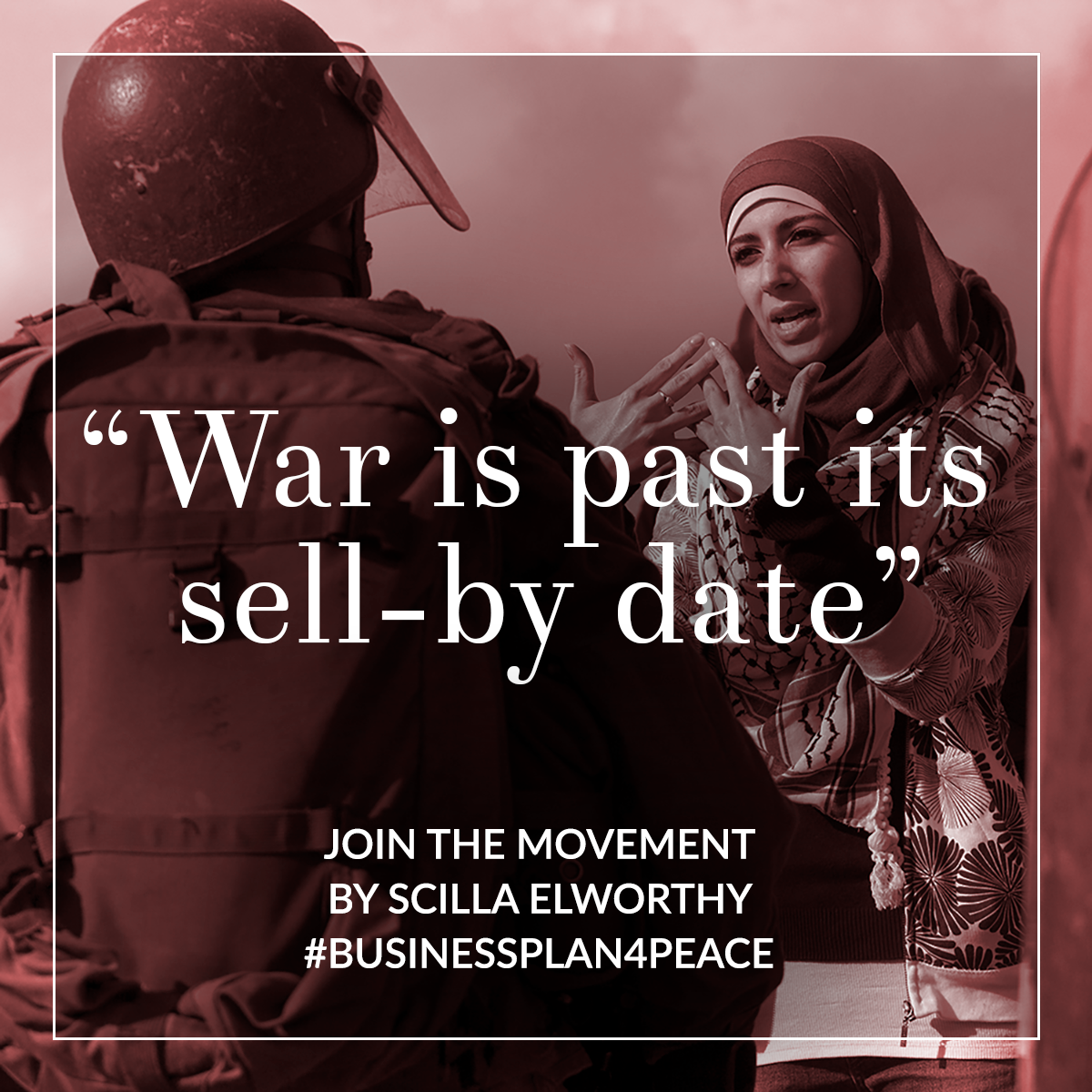Today, 21st September 2017, International Day of Peace, Dr Scilla Elworthy publishes her latest, incredible book
The Business Plan for Peace: Building a World Without War
Three times nominated for the Nobel Peace Prize, Scilla Elworthy now publishes the first ever business plan for peace, based on 40 years pioneering initiatives in the transformation of conflict. Detailing 25 viable methods on international, national and local levels, the book demonstrates that war can be prevented worldwide over a period of 10 years for less than 2 billion dollars. The final chapters present the kind of actions that anyone can take: 10 that can be undertaken locally, 14 nationally and 7 actions to take internationally.
- While war hits the front pages daily, peace is not considered sexy.
- Yet this book packs a punch with facts and figures detailing the forces that drive war and in sharp contrast showing what can be done to stop people killing each other.
- The total cost of scaling up all the most effective systems to prevent war over a period of 10 years would cost under $2 billion. Currently we spend $9 billion annually on ice cream.
- Peace doesn’t have to be a distant aim for idealists: on this International Day of Peace, here’s a chance to present the facts and figures of what can be done.
Scilla receives incessant requests on a daily basis, asking “what can I do?” given the current state of the world. Because of the urgency of offering answers, the book is published independently in paperback, and various e-versions. They can be purchased here.
Five key messages of the book
WHY WAR CONTINUES
War makes a few people extremely rich, and makes billions of people extremely poor. Every year, the world spends about $2 trillion on wars. The total value of the global arms trade alone was at least $94.5 billion in 2014. By contrast, just $10 billion would cover the cost of bringing clean water and sanitation to everyone on the planet. Those who thrive in war are not only arms manufacturers but also people traffickers, arms smugglers, money launderers, drug dealers — plus others who require a lawless environment to make a fortune.
HOW PEACE CAN BE BUILT
This book describes and references at least 25 proven systems that effectively prevent armed conflict and build safety at local, national and international levels. This is achieved through the methodical application of dialogue, prevention and early intervention, such as preventing the recruitment of suicide bombers in NW Pakistan. Each system is presented in detail, with examples of how it works in practice, followed by the plan of how it can now be implemented at scale.
WHAT IT WILL COST
Armed conflict causes massive economic losses every year, yet peace-building and peace-keeping are grossly under-funded. The spending in 2015 on peace-building ($6.8 billion) and peacekeeping ($8.27 billion) together represented just 2 per cent of the economic losses caused by conflict. This book demonstrates that the total cost of scaling up all the most effective systems to prevent war over a period of 10 years would cost under $2 billion. Currently we spend $9 billion annually on ice cream.
WHO CAN DO IT
The current exponential rise in citizen action shows how fast humanity is evolving toward a more awakened, empathic society. The book outlines what anyone who wants to be active to prevent violence and armed conflict can do: 10 actions to take in your community, 14 actions to take nationally and 7 actions to take internationally. It addresses the self-knowledge and inner development that is essential if people are to be effective in their efforts, and provides trusted exercises to develop the skills needed in order to become inspiring builders of peaceful societies.
WHY WOMEN ARE NEEDED
The research for this book has shown how vital is the work of women in stopping people killing each other. Example after example demonstrates their innate skill. Crisis Group has found that a peace agreement is 35% more likely to last at least 15 years if women participate in its creation, yet until recently women made up only 2.5% of signatories to peace agreements. Thousands more women are needed at every level. Peace-building cannot succeed if half the population is excluded from the process.
EXCERPTS
p.14: The result of rape as a weapon of war is to extend post-conflict chaos because the children born have no idea who is their father; moreover the anguish of a woman who has given birth to a child whose father is the ‘enemy’ can only be imagined.
p.16: “War is past its sell-by date”
p.21: Five of the world’s six largest arms sellers are the five Permanent Members of the UN Security Council. This explains why efforts to curb the arms trade have so far failed.
p.27: “After seven days [in Iraq, Jan 2003] we had collected enough positive information to condense it into a two-page Plan to Tony Blair, outlining in ten points how war could be avoided. It was placed in Blair’s hands a few days later. I heard that he read it quickly and said, “It’s too late.” For Blair, it was. Two months later we discovered that irreversible machinery for the US/UK invasion had been set in motion the previous October and that Blair had given Bush his unconditional support a year previously.”
p.34: Attempts to stop war from the top down often fail because of the mind-sets — fear, aggression, competition, greed — qualities shared by most of those leaders filtered to the top by our current systems. One of the best ways to overcome the force of these attitudes and emotions is by systematically building trust through dialogue.
p.79: If a pragmatic approach can be adopted that links these local, national, regional and global objectives into a whole system, it will be possible to transform the twenty-first century into a century of peace.
p.82: The total peace dividend the international community would reap if it doubled peacebuilding commitments over the next ten years is calculated to be US$2.94 trillion.
p.95: …global military expenditure in 2016 was $1686 billion. That is just for one year. With a world population of 7.6 billion118, this equals to $221.8 for every person on the planet. The [above] calculation to bring a global Peace Plan into action is estimated to cost $1,942,400,000 for ten years, just under two billion, or approx. $194,240,000 for one year. With a world population of 7,600,000,000, this equals just under 3 cents for every person on the planet.
p.104: Those filtered to the top by our current political systems tend by nature to be better at argument, competition and aggression than listening, mediation and compassion. That’s the name of the game, currently. And that’s why attempts to stop war from the top down are so prone to failure. Syria is a current example. So something different is required. And in my observation something different is happening. We have already seen that locally-led initiatives to prevent conflict in the most violent parts of the world have increased four-fold, and we have become familiar with the incredible courage of people risking their lives to stop war at the sharp end.
p.107: Perhaps more profound and far-reaching than any other current phenomena is the shift from a paternalistic ‘top down’ approach to change (“the leaders are in charge”) to a laterally organised ‘bottom up’ series of initiatives springing up all over the globe.
See the video trailer for the book here.
For a free hard copy or e-copy please supply name, media organisation and address to us at [email protected] and we’ll get that over to you.

